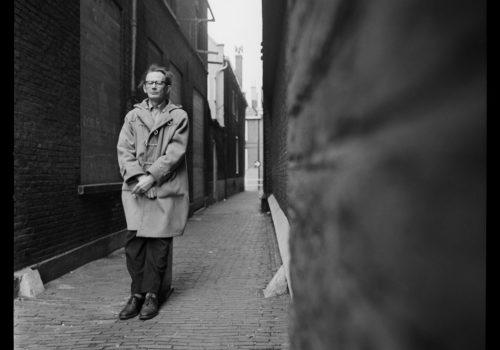The gallery dedicated to the work of German photographer Lothar Wolleh tells the story of a friendship woven around the arts, that of two characters whose practices have marked their respective countries, Germany and the Netherlands. In the background, Delft, birthplace of visual artist Jan Schoonhoven, also his muse.
Light, shadow and structure are the photographic imprint of Lothar Wolleh (1930-1979), admirer and friend of the artists whose dense work was preserved and revealed by his son, Oliver Wolleh. If his portraits of artists are famous, his name is less so. However, Lothar Wolleh created portraits and documented the artistic practice of more than 160 figures during his career, from Joseph Beuys to Gerhard Richter, including René Magritte, Niki de Saint-Phalle and Jan Schoonhoven (1914-1994): Dutch artist known for his monochrome reliefs, made of cardboard, paper and painted with acrylic.
Delft – Düsseldorf
In the winter of 1968, Lothar Wolleh joined Schoonhoven in Delft with the desire to immerse himself in his world – as he is used to work in order to grasp the inextricable aspects of his subjects. This meeting between Schoonhoven and Wolleh crystallizes the artistic connection of the time between two cities, those of Delft and Düsseldorf, where Wolleh lives and works as an advertising photographer.
A few years earlier, at the dawn of the 1960s, Schoonhoven co-founded the experimental group “NUL”, the Dutch branch of the international group “ZERO” initiated by the artists Heinz Mack and Otto Piene in Düsseldorf and of which Wolleh was a fervent connoisseur. This school, born from a radically modern approach, overturns the easel to stimulate the new artistic departure of a Germany culturally damaged by the war. In the Netherlands, Schoonhoven and his group advocated for an “objective and neutral representation of reality”, resulting, for the artist, in a serial exploration of the grid pattern, a rejection of color and a particular sensitivity to the light.
Shadow – Light
This light, just as decisive in the life of Lothar Wolleh, will guide his photographic approach. Wolleh saw his childhood home in the Wedding district destroyed during the Second World War by Allied bombings. In 1951, he was sentenced to six years of forced labor in Soviet gulags in Siberia on suspicion of spying on the communist regime for the benefit of the American Enemy. However, at the heart of this episode of horror and darkness during which Wolleh made a makeshift camera, the northern lights that he admired there forged in him a fascination for light which led him to photography.
In Wolleh’s portraits, the shadows and lights are so high that they deliberately hide details of the depth of field, giving a structural dimension to the image. Oliver Wolleh himself confides that restoring his father’s photographs as they were intended required a lot of work to understand his practice and therefore his experience.
Rigor – Sensitivity
As for Schoonhoven, although recognized and even rewarded during his lifetime, the artist retained his position at the PTT (post, telephone and telegraph) in La Hague until 1979. Delft, his hometown, is only about twenty minutes away. Lothar Wolleh photographs him at the heart of his creative process as if nestled in the streets of Delft. The intimate space of the Lothar Wolleh Raum devotes an entire wall to Schoonhoven’s hands at work, captured from above by Wolleh, in a succession of shots a few seconds apart. A painting that resonates with the repetitive process of motifs, characteristic of the artist’s conceptual approach.
This rigor in Schoonhoven’s practice and this sensitivity to the rudimentary materials he uses shines through in Wolleh’s photos, who plays with perspectives to offer compositions faithful to the artist’s personality. This is the case with the cobblestones of the streets of Delft, an important source of inspiration for Schoonhoven’s grids, he captures him from above lighting a cigarette, as a tribute to this reference. Lothar Wolleh is irremediably a master of portraiture, managing here to capture, with the help of his hasselblad, each constituent element of the artist: his dandy appearance, his taste for churches, his obsession with lines and geometric shapes or even , his perpetual search for movement and rhythm.
Noémie de Bellaigue
“A Gaze upon Delft” at the Lothar Wolleh Raum until September 6, 2024
Lothar Wolleh Raum
Linienstraße 83A,
10119 Berlin
















